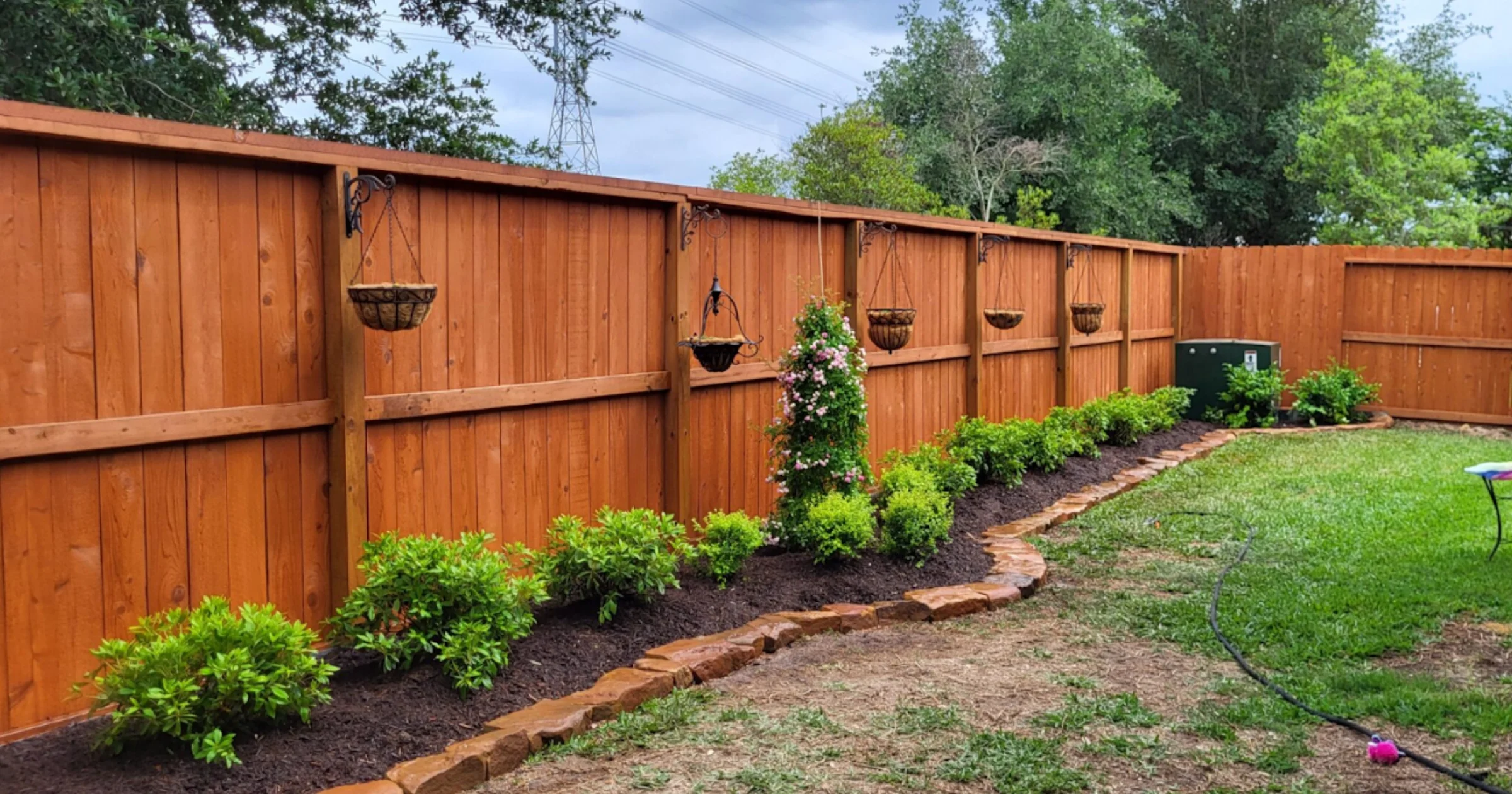
Fence and deck staining projects raise legitimate concerns about potential plant damage from overspray and chemical exposure. Houston homeowners investing in landscaping naturally worry about protecting their gardens, grass, and established vegetation during wood staining applications.
Fence and deck staining can indeed damage plants if proper precautions are not implemented. Different plant types exhibit varying levels of vulnerability to stain overspray, with some recovering quickly while others may suffer permanent damage or death.
Understanding plant vulnerability levels and implementing appropriate protection measures ensures successful fence and deck staining projects without compromising valuable landscaping investments. Before starting any staining project, homeowners should understand how to prepare for fence staining day to minimize risks to both wood and vegetation. Professional application techniques combined with proper plant protection maintain both wood and garden health.
Plant Vulnerability During Fence and Deck Staining Projects
Grass and Lawn Areas
Grass demonstrates moderate resilience to fence and deck staining overspray but still requires protection to prevent damage. Stain contact typically causes browning along fence lines and around deck perimeters, creating unsightly strips that detract from overall lawn appearance.
Recovery patterns for grass depend on overspray severity and grass type. Most established turf recovers within 1-2 weeks with proper watering and care. However, severe overspray exposure may require reseeding or sod replacement in affected areas.
New or recently seeded grass shows higher vulnerability to fence and deck staining chemicals and may experience more extensive damage requiring complete replanting.
Newly Planted Flowers and Garden Beds
Newly planted flowers represent the most vulnerable category during fence and deck staining applications. Young root systems and delicate foliage cannot withstand chemical exposure from stain overspray, whether from fence or deck projects.
Delicate flowering plants will likely die from direct stain contact, particularly those planted within the previous growing season. Raised flower beds near fences and decks require maximum protection during staining projects.
Established perennial flowers show better resilience but may still experience leaf damage and flowering disruption from stain exposure during fence and deck staining work.
Large Trees and Shrubs
Mature trees and shrubs rarely die from fence and deck staining overspray but experience cosmetic damage that affects appearance for extended periods. Stain contact causes leaf browning and premature leaf drop, creating unsightly appearance until natural regrowth occurs.
Large established plants possess extensive root systems that support recovery from leaf damage. However, the cosmetic impact can persist through multiple growing seasons depending on the plant species and stain exposure level.
Evergreen shrubs may show more persistent damage than deciduous plants, as needle replacement occurs more slowly than leaf regrowth.
Vegetable Gardens
Vegetable gardens represent high-risk areas during fence and deck staining applications due to food safety concerns and plant sensitivity. Stain overspray can render produce inedible and may kill vegetable plants entirely.
Chemical residues on edible plants create health hazards that persist beyond the growing season. Even minimal fence and deck staining overspray on vegetable gardens requires harvesting cessation and potentially replanting.
Root vegetables may absorb chemicals through soil contamination, creating food safety issues that extend beyond surface contact damage. For homeowners with extensive vegetable gardens near fencing, understanding why your wood fence turns gray and how staining prevents it helps justify the importance of proper wood protection while implementing necessary plant safety measures.
Climbing Plants and Vines on Fences
Vines and climbing plants growing on fence surfaces must be removed before fence and deck staining applications. These plants prevent proper stain coverage on wood surfaces while suffering extensive damage from direct chemical exposure.
Removal and regrowth represent necessary steps in the staining process. Attempting to work around established vines results in inadequate wood protection and plant death during fence and deck staining projects.
Most vine species recover from aggressive pruning better than chemical exposure, making removal the preferred protection method.
Plant Protection Methods During Fence and Deck Staining
Relocation of Portable Plants
Potted plants and hanging baskets should be moved completely away from fence and deck staining work areas. Relocation eliminates exposure risk while allowing normal plant care to continue during project completion.
Relocated plants require placement in appropriate light conditions and regular watering schedules. Temporary relocation stress is minimal compared to chemical exposure damage from fence and deck staining overspray.
Ground Cover Protection Techniques
In-ground plants require covering with breathable cloth drop cloths rather than plastic sheeting. Plastic covering creates heat buildup that can kill plants within 2-3 hours under Houston’s intense summer sun.
Fence and deck staining protection requires timing coordination to minimize covering duration. Plants should only remain covered during active staining of adjacent fence sections, with immediate uncovering once application is complete.
Cloth materials allow air circulation while providing chemical barrier protection. Multiple cloth layers may be necessary for plants in high-overspray zones.
Application Method Selection
Fence and deck staining application methods significantly impact overspray potential and plant protection requirements. Brush and roller applications provide maximum control and minimal overspray risk compared to spray methods for both fence and deck surfaces.
When spray application is necessary for efficiency on large deck areas or extensive fencing, additional plant protection measures become critical. Working in controlled sections with comprehensive covering reduces plant exposure risk during fence and deck staining projects.
Professional applicators adjust techniques based on surrounding vegetation density and value, prioritizing plant protection while maintaining application quality for both fence and deck surfaces.
Professional Plant Protection Protocols
Comprehensive Site Assessment
Professional fence and deck staining services conduct thorough property assessments to identify vulnerable plants and high-risk areas around both fence lines and deck perimeters. This evaluation determines appropriate protection levels for different vegetation types.
Assessment includes plant identification, value evaluation, and protection requirement determination for both fence and deck staining areas. Valuable or irreplaceable plants receive maximum protection measures regardless of project complexity.
Systematic Protection Implementation
Experienced contractors implement systematic plant protection that coordinates with fence and deck staining application sequences. Protection timing minimizes plant stress while ensuring adequate chemical barrier coverage for both types of staining projects.
Professional protocols include plant relocation assistance, appropriate covering material selection, and timing coordination that prevents overheating or moisture buildup under protective covers during fence and deck staining work.
Specialized Equipment and Techniques
Professional fence and deck staining applications utilize equipment and techniques that minimize overspray while maintaining application quality for both fence and deck surfaces. Controlled application methods reduce plant protection requirements while ensuring wood coverage adequacy.
Specialized masking materials and application tools allow precise work near valuable landscaping without compromising either wood protection or plant health during fence and deck staining projects.
Houston Climate Considerations for Plant Protection

Heat Stress Prevention
Houston’s intense summer heat creates additional plant stress during fence and deck staining projects. Protective covering combined with high temperatures can kill plants within hours if not properly managed.
Fence and deck staining scheduling during cooler periods reduces heat stress on protected plants. Early morning or late afternoon applications minimize temperature-related plant damage risk for both fence and deck projects.
Humidity and Moisture Management
High humidity levels in Houston create moisture buildup under plant coverings that can promote fungal issues or suffocation. Proper ventilation and covering duration management prevent moisture-related plant damage.
Fence and deck staining timing coordination becomes critical in humid conditions to minimize protective covering duration while ensuring adequate chemical protection.
Seasonal Application Timing
Houston’s growing seasons influence plant vulnerability during fence and deck staining projects. Dormant season applications reduce active plant damage risk, though protection remains necessary for evergreen species.
Active growing season projects require enhanced protection measures due to increased plant vulnerability and growth activity.
Long-term Landscape Recovery
Recovery Timeline Expectations
Different plant types exhibit varying recovery patterns following fence and deck staining exposure or protection stress. Understanding recovery timelines helps homeowners plan landscape maintenance and replacement needs.
Grass typically recovers within 2-4 weeks with proper care. Shrubs and trees may require a full growing season for complete recovery. Damaged annual flowers usually require replacement.
Maintenance Adjustments
Plants affected by fence and deck staining overspray or protection stress may require adjusted care routines during recovery periods. Increased watering, fertilization, or pruning may be necessary to support recovery.
Professional landscape consultation may be beneficial for valuable plants showing stress symptoms following fence and deck staining projects.
Making Informed Decisions About Plant Protection
Fence and deck staining projects can successfully coexist with valuable landscaping through proper planning and protection implementation. Understanding plant vulnerability levels and protection requirements ensures optimal outcomes for both wood and garden investments.
Professional services provide expertise in plant protection that eliminates guesswork and reduces damage risk. Experienced contractors coordinate application methods with protection measures to maintain both wood and landscape quality during fence and deck staining projects.
The investment in proper plant protection during staining projects prevents costly landscape replacement and maintains property value. Comprehensive protection measures cost significantly less than plant replacement and landscape restoration.
For Houston homeowners with valuable landscaping, professional services offer the expertise and equipment necessary to protect plants while achieving optimal wood protection. Our experienced team provides complete fence staining and professional deck staining services that prioritize both wood and landscape protection.
Serving Cypress, Houston, Tomball, and The Woodlands, we understand the importance of protecting your landscaping investment during fence and deck staining projects. Contact Ninja Fence Staining at (832) 258-6164 for expert guidance on plant-safe staining applications.

